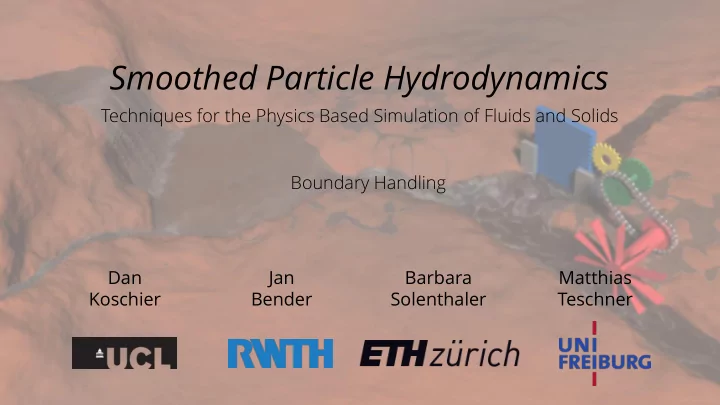

Smoothed Particle Hydrodynamics Techniques for the Physics Based Simulation of Fluids and Solids Boundary Handling Dan Jan Barbara Matthias Koschier Bender Solenthaler Teschner
SPH Fluid Solver Neighbor search Incompressibility Boundary handling SPH for the Physics Based Simulation of Fluids and Solids – 55
Outline Particle boundaries Current developments SPH for the Physics Based Simulation of Fluids and Solids – 56
Concept Boundaries are sampled with particles that contribute to density, pressure and pressure acceleration of the fluid Kernel support Fluid particle Solid particles Boundary handling: How to compute ? SPH for the Physics Based Simulation of Fluids and Solids – 57
Several Layers with Uniform Boundary Samples Boundary particles are handled as static fluid samples Boundary neighbors contribute to the density All samples have the same size, i.e. same Fluid mass and rest density Solid Pressure acceleration All samples have the same size, i.e. same mass and rest density Contributions from fluid neighbors Contributions from boundary neighbors SPH for the Physics Based Simulation of Fluids and Solids – 58
Pressure at Boundary Samples Pressure acceleration at boundaries requires pressure at boundary samples Various solutions, e.g. mirroring, extrapolation, PPE Mirroring Formulation with unknown boundary pressure Mirroring of pressure and density from fluid to boundary SPH for the Physics Based Simulation of Fluids and Solids – 59
Boundary Contribution to Pressure Acceleration SPH for the Physics Based Simulation of Fluids and Solids – 60
One Layer of Uniform Boundary Samples Contributions of missing samples have to be added x is an approximation of the contribution from missing samples Fluid Offset typically implemen- ted as scaling coefficient Solid Kernel Missing property samples Pressure acceleration Kernel gradient property Pseudo inverse SPH for the Physics Based Simulation of Fluids and Solids – 61
Correction of Missing Contributions The motivation of and is to compensate contributions of missing samples to SPH for the Physics Based Simulation of Fluids and Solids – 62
One Layer of Non-Uniform Boundary Samples Non-uniform contributions from boundary samples Non-uniform sizes, i.e. masses of boundary samples Fluid Contribution, i.e. mass of a boundary sample is Solid approximated from its Missing boundary neighbors samples Pressure acceleration SPH for the Physics Based Simulation of Fluids and Solids – 63
One Layer of Non-Uniform Boundary Samples For arbitrary sampling For perfect sampling For perfect sampling In 3D, SPH for the Physics Based Simulation of Fluids and Solids – 64
Typical Boundary Representation Color-coded volume Boundary samples of boundary samples SPH for the Physics Based Simulation of Fluids and Solids – 65
Rigid-Fluid Coupling SPH for the Physics Based Simulation of Fluids and Solids – 66
Rigid-Fluid Coupling SPH for the Physics Based Simulation of Fluids and Solids – 67
Summary Boundary is sampled with static fluid particles One layer of non-uniform samples Arbitrary triangulated meshes can be used as boundary Non-uniform boundary samples can be handled Missing contributions to fluid density and pressure acceleration have to be corrected Pressure is mirrored from fluid to boundary SPH for the Physics Based Simulation of Fluids and Solids – 68
Outline Particle boundaries Current developments SPH for the Physics Based Simulation of Fluids and Solids – 69
Current Developments Pressure extrapolation [Adami 2012, Band 2018] Solving boundary pressure with a PPE [Band 2018] Density maps [Koschier 2017] Precomputing boundary contributions to the density computation of nearby fluid particles SPH for the Physics Based Simulation of Fluids and Solids – 70
SPH Fluid Solver Neighbor search Incompressibility Boundary handling SPH for the Physics Based Simulation of Fluids and Solids – 71
Recommend
More recommend